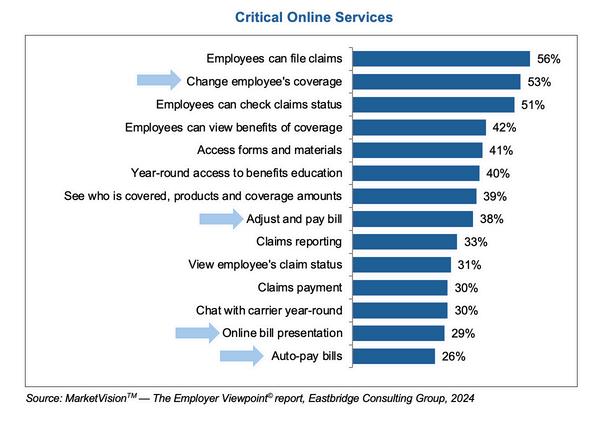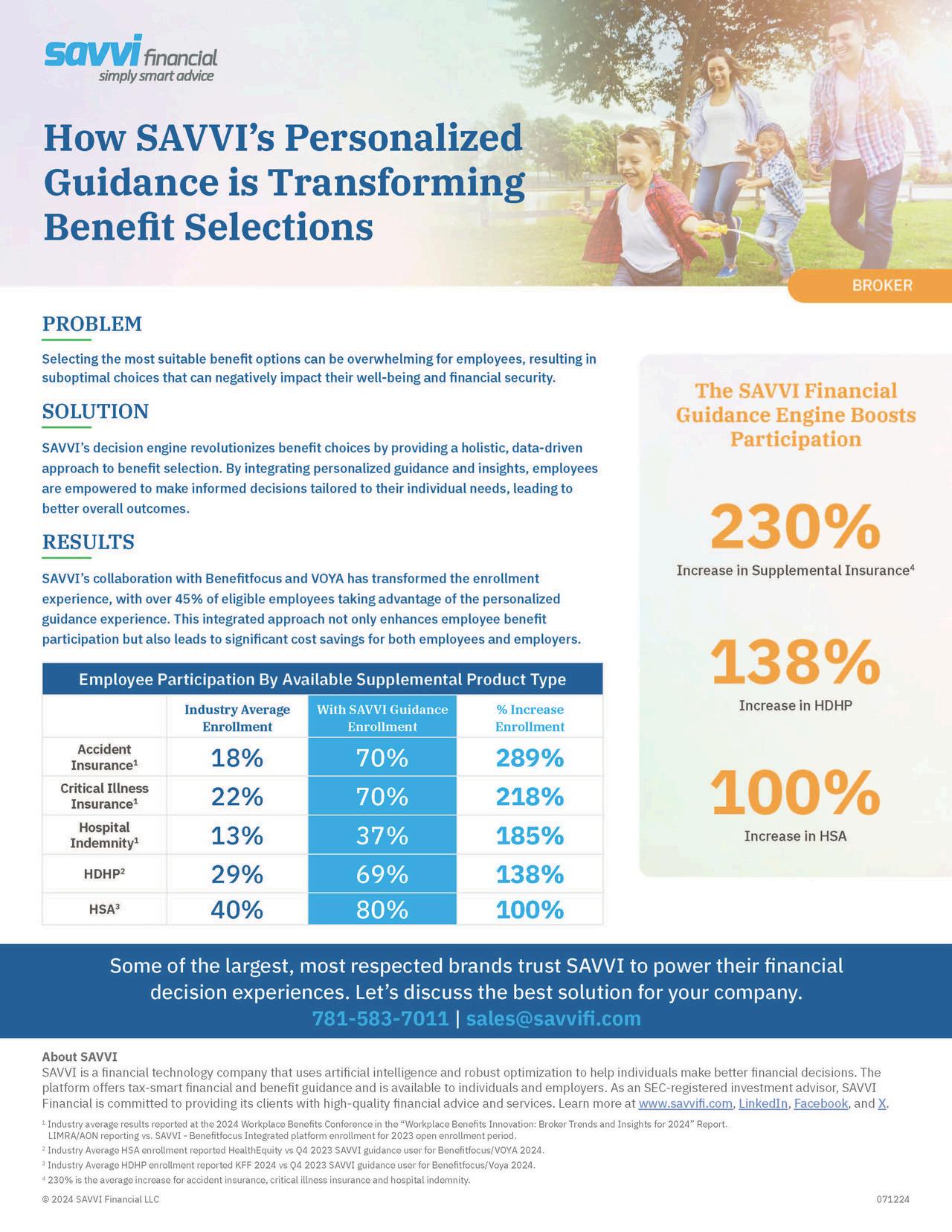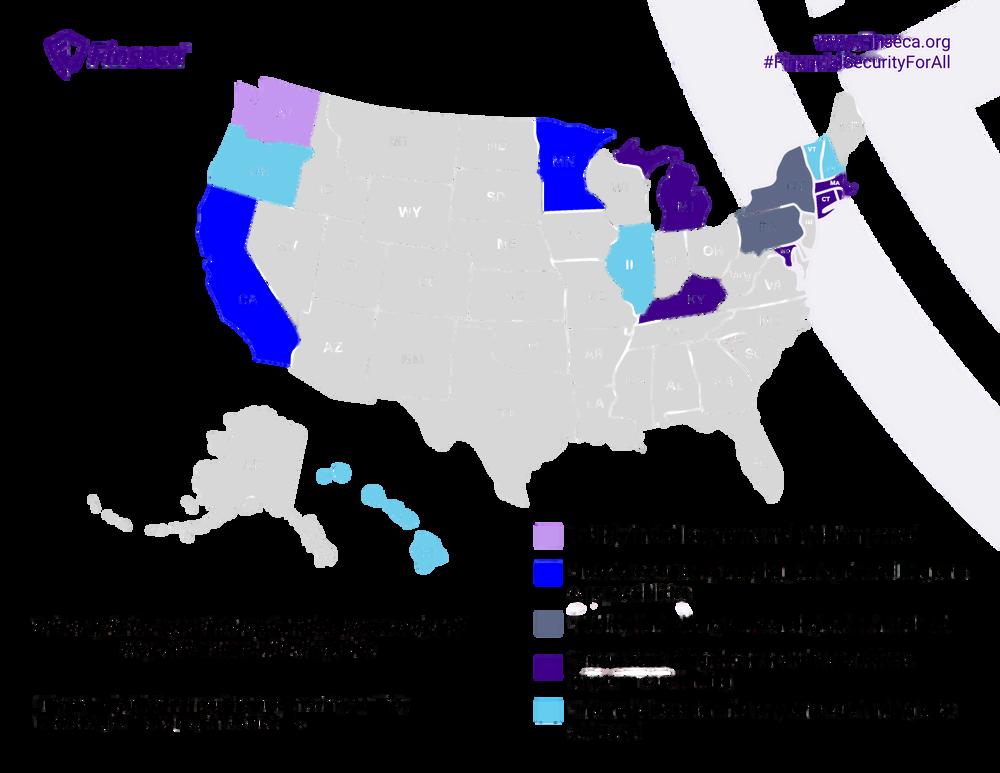







Steve Cain



Editors
Heather Garbers | Trevor Garbers
For Media and Marketing Requests Contact:
Heather@voluntary-advantage com
Trevor@voluntary-advantage com
Mailing Address
10940 S Parker Rd #257 Parker, Colorado 80134

Steve Clabaugh CLU, ChFC
Jennifer Daniel Aflac

Jack Holder EBIS

Paul Hummel UHC

Rachel McCarter Mercer

Mark Rosenthal PwC

Seif Saghri BenefitHub
Tim Schnoor Birch Benefits
Sydney Consulting Group A d v i s o r y B o a r d


Hunter Sexton, JD, MHA

The Evolving PFML Landscape: What to Expect in 2025 and Beyond Voices of Voluntary Benefits
Worksite LTC Insurance: What Benefits Professionals Need to Know
Now What? How to Have a Championship Team Discussion

Show Me the Money: Better Billing Processes Can Create a Better Customer Experience

The Mental Health Parity Act: What Brokers Need to Know
To go forward, it’s always intriguing to look at how our marketplace has evolved over the past few decades Let’s start at 25 years ago, the conversation was basically, I hope to get a chance to present my 2-3 benefits at the very end of the renewal meeting If not, maybe we’ll try again next year If selected, you would head to the infamous lunchroom with a card table where you would give away free trinkets in hopes to sign someone up via a paper application. A few years later, we introduced advancing tech and enrollment solutions where we carried laptops and became masters of parking at McDonalds “to borrow” Wi-Fi and upload our applications each day Next, we saw a mass migration of these products and services come into the broker/brokerage marketplace, where us brokers heard countless times that “we are leaving money on the table” and these benefits are “offered at no cost to the employer!” Side note, if you are still using either of these two sales approaches today – just please stop on behalf of all of us!

With March being – The Month of Change; I have zero hesitation as I share with you my first two-months of 2025. In these two first months, we packed our calendar with key executive meetings which included industry leaders ranging from private equity firms, stand-alone startups, carrier executives, technology firm leaders and many others and I’m incredibly excited to share that I firmly believe our marketplace has evolved more in the past 1214 months, than it did in the past 25 years combined Yes, that’s an incredibly bold statement and here is my how and why
First, we are finally placing the policyholder first in everything we do today Example: We recently met with key trading partners/carriers and each meeting started off with how they are approaching claims, claims automation and the policyholder experience If you are not placing this as a top priority, you will quickly fall off broker panels, key accounts, etc. Note: We are still a long way from the finish line as “wordsmithing” is at an all-time high when given trading partners explain their claims solutions to a broker/consultant or client. My one bit of advice is, to never assume that your audience is not fully aware of the differences in each offering Be upfront, direct and accurate in what you can and cannot execute today A.I. – And it’s positive outcome around total cost case management. Today, we are seeing pilot projects in place where a carrier has one point of contact for a given brokerage, underwriting is being assisted by AI at the brokerage, broker, client and policyholder level combined – not just at the case level Then, executed by a self-service enrollment Yes, human involvement and relationship building matter, however it’s evolving at a record pace, and it will look fundamentally different in the next 2-3 years
Fundamentally, ongoing discussions around both carrier and broker compensation models will be solved when we start looking at whole case/brokerage U.W. which is driven by A.I. Today, the data is there – it’s now a race to who can master it and produce a solution that meets the needs of all stakeholders.
API’s – Outside VC entities are making it so this is a standard within our marketplace. Gone are the discussions of, we have API for accident and by the end of 26’ we hope to add two other lines Over API’s have such an impact on the overall enrollment and ongoing administrative experience that they need to be fast tracked on all lines We are seeing entities start to not even send out quotes to trading partners unless they have a full set of product API’s for data transfers regarding enrollment, implementation, reenrollments and claims
In closing, this was a quick snapshot of change for March 2025 We have an absolute wealth of runway in front of us to build our solution the right way for the next 25 years, that not only await our marketplace but will fully depend on the financial vehicles that we are creating right now in protecting the ones we love.

By Eastbridge Consulting Group
There’s good news and bad news when it comes to employers and voluntary billing.
First, the bad news: Billing for voluntary products continues to cause problems for many employers One in five employers surveyed for Eastbridge’s “MarketVision™ The Employer Viewpoint©” report list billing problems as an administrative pain point
The good news is, it appears carriers are making progress on this front The number of employers citing billing as a pain point has dropped steadily in recent years, from 35% in 2020 to 26% in 2022 and 20% in 2024.
This is important because, unlike other tasks such as; getting products set up on their benefits administration system or coordinating the annual enrollment, billing is a task employers deal with all year Eastbridge research shows the quality and reliability of billing processes is a key capability carriers must get right in fact, it’s one of the most important factors employers consider when choosing a voluntary carrier Carriers, brokers and employers who work together early in the process are more likely to ensure their preferences, expectations and capabilities for voluntary billing align.
Here are several key findings from our recent research into voluntary billing that carriers, brokers and employers can use to help create the best possible customer experience.

Employers with billing problems cite multiple reasons, but the most common cause is evidence of insurability Carriers may need to bill retroactively or refund premiums, depending on how they handle coverages subject to EOI. Self-billing and list-billing also cause problems for many employers. Selfbilling tends to be simpler, but can cause delays in claims payment if carriers don’t require a regular eligibility file from their clients. List-billing can create issues if carriers don’t include a tolerance allowance for minor payment discrepancies Employers also name API data exchanges and other electronic data interchanges as the sources of billing problems
Most employers (nearly 80%) work with multiple carriers for different types of coverage, including major medical, core or group, and retirement products However, employers are split on how they want to be billed for these products: 40% say they prefer the medical and/or core group benefits to be on the same bill as voluntary products, but almost as many (38%) prefer a separate bill for voluntary, while 22% indicate no preference
Online services are important to virtually all employers: a third won’t use a carrier that doesn’t offer online administration, and only 4% say online services aren’t important And many of the online capabilities employers consider critical relate to billing, including changing employees’ coverage, viewing bills, adjusting and paying bills, and automatic bill payment.
Despite the demand for online services, most employers still pay their bills by paper check. And all carriers surveyed in Eastbridge’s “Billing Practices of Voluntary Carriers” Spotlight™ report will accept that payment method, even though they have a strong preference for electronic methods such as ACH/auto-draft, web/online, electronic funds transfer or wire transfer
Most carriers also are flexible in bill types by group size, although some require larger groups to use self-billing The majority of carriers surveyed also allow third-party administrators to bill for their products after completing a due diligence process


Our study shows most carriers leave it up to employers to determine the payroll deduction amounts for their employees’ voluntary coverage Many ben-admin platforms provide this information for employers, but if they don’t, carriers can help by providing an electronic payroll deduction file or calculation instructions for employers to determine their payroll deduction amounts This can improve the billing experience through better accuracy and reduced follow-up when the amounts employers pay don’t match the amounts on the bill


Eastbridge is the source for research, experience, and advice for companies competing in the voluntary space and for those wishing to enter For over 25 years, they have built the industry’s leading data warehouse and industry-specific consulting practice. Today, 20 of the 25 largest voluntary/worksite carriers are both consulting and research clients of Eastbridge.

VoluntaryAdvantageispartneringwithEastbridgeConsultingGroupto producetheindustry’smostcomprehensiveannualstudyofbrokerbest practices,preferencesandchallenges
IfyouareaBroker/Producer/Consultant-pleaseshareyourperspectiveonkeytopics andmarkettrendsinthevoluntary/worksiteindustryinaquick15-minuteonline survey.Ifyouparticipateinthesurvey,youwillreceiveinvite-onlyaccesstoan exclusivewebinarthathighlightskeytopicsfromthesurveyresults!
Eastbridgewillusethenewdatatoupdateresearchbasedonannualbrokersurveys ithasconductedsince2013andwilldistributethefindingsinareporttocarriers participatinginitsInformationPartner™program.Thesecarrierscanusethe informationtogainimportantinsightsfromakeystakeholdergrouptohelpdrivetheir strategicdecision-making.
Theobjectiveofthesurveyistotrackvoluntary/worksitebrokersbestpractices, preferencesandchallengeswithinthevoluntary/worksiteindustry.Keytopicsinclude: salesgrowth,voluntaryproducts,claimsintegration,enrollment,technologyfunding andcarrierselectioncriteria.


By PES Benefits
Mental health care is just as important as physical health care, yet for many years, insurance plans didn’t treat them equally. The Mental Health Parity and Addiction Equity Act (MHPAEA) was created to change that This law requires most health insurance plans to cover mental health and substance use disorder (SUD) services at the same level as medical and surgical care That means no extra limits on visits, no higher copays, and no unfair restrictions that make it harder for people to get the care they need
57% of workers dissatisfied with their employer’s mental health and well-being support intended to seek employment elsewhere within the next year
Source:AmericanPsychologicalAssociation
In 2023, the Department of Labor's Employee Benefits Security Administration (EBSA) conducted 187 investigations related to MHPAEA compliance, resulting in 15 citations for violations.
Source: U.S. Department of Labor
For employee benefits brokers, understanding MHPAEA is key to helping clients offer the best possible benefits Here are five important things brokers should know about the law and how virtual mental health care can help bridge the gaps:
Many people think "parity" just means equal costs for mental health and medical care, but the law goes further It ensures that treatment limits, prior authorization rules, and provider network access for mental health services are no more restrictive than for physical health care. Brokers should help clients review their plans to make sure they are compliant.
Even if a health plan covers mental health services, it must also provide access to an adequate number of in-network providers This has been a challenge, as there is a nationwide shortage of mental health professionals Virtual mental health care solutions can help by expanding provider networks and making care more accessible to employees, no matter where they live
Are Increasing. Regulators are cracking down on noncompliant plans. The Department of Labor is conducting more audits and enforcing penalties on employers and insurers that don’t meet MHPAEA standards. Brokers can add value by helping clients conduct a self-audit to ensure their plans meet the law’s requirements
Mental Health Coverage Improves Workforce Productivity. Employees struggling with untreated mental health conditions are more likely to experience absenteeism, presenteeism, and reduced productivity
By ensuring compliance with MHPAEA and promoting virtual counseling, therapy, and psychiatric services, brokers can help employers improve workforce well-being while reducing healthcare costs associated with untreated mental health issues.
Even with MHPAEA in place, stigma, wait times, and provider shortages remain barriers to care. Virtual mental health services, like on-demand counseling, therapy, and psychiatry, can help employees access the support they need without long wait times or the pressure of inperson visits Offering a virtual mental health care option alongside improved insurance coverage ensures employees get the right level of support, when and where they need it
As of December 2023, more than half (169 million) of the U.S. population lives in a Mental Health Professional Shortage Area [1]
In 2022, approximately 59 million U.S. adults (23% of all U.S. adults) had a mental illness and nearly half of them did not receive treatment [2]
Behavioral health services can be difficult to access due to behavioral health provider shortages, high out-of-pocket costs, coverage gaps, and other factors [3] For example, 6 in 10 psychologists do not accept new patients,11 and the national average wait time for behavioral health services is 48 days [4]
The Mental Health Parity Act has made significant strides in ensuring fair coverage for mental health care, but challenges remain. Brokers play a crucial role in helping employers navigate compliance, expand access to care, and adopt solutions like virtual mental health services that improve employee well-being. By staying informed and proactive, brokers can help their clients offer benefits that truly support the whole employee mind and body.

PES Benefits is dedicated to revolutionizing the employee benefits landscape with cutting-edge technology, administration, education, and virtual care solutions Since its inception, PES Benefits has focused on simplifying the benefits experience, making it more accessible and meaningful for all involved.





By Tara Athy, J.D. and Annie Jantz
Workplace benefits continue to evolve as the focus intensifies on employee well-being To help financially support employees during personal or family medical needs, more states are creating their versions of Paid Family and Medical Leave (PFML) legislation With new laws being introduced and existing ones being updated, it’s critical for employers and employees to stay informed about the latest developments
Before we look forward, a look back at 2024 shows how these current laws continue to evolve The momentum of state-mandated leave isn’t slowing down, so it’s important to learn from their success and issues as these PFML programs influence other state programs. These highlights offer a glimpse of what’s to come in 2025 and beyond.
States that have implemented PFML consistently monitor their programs to ensure they meet the needs of their workers Typically, states will raise benefits periodically and allow states to adjust for the cost of living and wage levels and keep the program sustainable
While the frequencies and requirements differ, states are increasingly asking employers to renew their private plan exemption with the respective state agencies Therefore, employers must stay on top of renewal and reporting due dates or risk losing their private plan
Colorado, for example, started requiring private plans to complete an Annual Private Plan Attestation Employer Task that confirms their contact information and validates that their private plan still meets state requirements The attestation is due every November, and if an employer misses the deadline, Colorado will withdraw private plan approval and default the employer into the state plan This annual report is in addition to quarterly claims summary reports
Therefore, it is extremely important to watch for program changes and dates concerning private plan renewals and reporting.
Some states have also expanded eligibility for their state plans as they mature. In 2024, Connecticut strived to make its plan more inclusive, covering federally recognized tribes that are registered with the CT Paid Leave Authority. It also added sexual assault as a new covered leave reason under CT PFML.
Oregon expanded the reach of its program last year, too It added “bias crime” as a covered safe leave reason to include survivors of crimes that are motivated by bias against race, color, disability, religion, natural origin, sexual orientation, or gender identity
Furthermore, it added pre-placement leave for foster/adoption as a qualifying reason It allows time for prospective foster or adoptive parents to attend counseling sessions, appear in court, consult with an attorney, submit to a physical examination or home study, or travel to another state or country to complete an adoption
One of the most complicated topics is the coordination of benefits between the statemandated programs and employer voluntary benefits, such as short-term disability, employer-provided leave policies, or other accrued time off. A couple of states worked to amend current programs to address some of the questions surrounding coordination of benefits
Set reminders for renewals and reporting dates. Work with your internal team or payroll company to ensure you can pull the required information.
Track important dates and state changes through a reputable resource.
For example, Connecticut refined its leave program so employees can simultaneously receive paid family leave benefits with compensation from the state victim compensation program if it doesn’t exceed the individual’s regular compensation rate
In Oregon, employees can now use accrued time off from their employer while receiving paid family leave benefits to reach 100% of their wages And it clarified that child support obligations can be withheld from OR PFML benefits attributed to medical or family leave (not safe leave)
It also worked to remove most of the overlapping leave reasons under the Oregon Family Leave Act (OFLA) and OR PFML. Pregnancy disability and sick child leave if the child has a serious health condition are qualifying leave reasons under both OFLA and OR PFML but cannot run concurrently.
Four highly anticipated PFML programs are expected to launch in 2026 That’s why employers and benefit professionals should keep a close eye on Delaware, Maine, Maryland, and Minnesota as these states release more program information and requirements. Here are some highlights of what is known so far.
The Delaware PFML program will begin on January 1, 2026. The program covers parental, family caregiving, qualified exigency and employee’s own serious health conditions.
Employers were able to start withholding employee contributions for state plans on January 1, 2025 The first due date for both employer and employee contributions to the state is April 30, 2025 Employers that missed the private plan exemption deadline can still apply for a private plan exemption between October 1 and December 1, 2025, but will owe state plan contributions for the 2025 calendar year
Employers must submit quarterly wage and hour reports through the state’s LaborFirst portal by the 30th day after the end of each quarter. The first report for state plans is due April 30, 2025.
The Maine PFML program is currently set to begin in May 2026, providing eligible private and public employees with 12 weeks of paid time off for family or medical leave. Qualified leave includes caring for a sick family member, birth of a child, qualified exigency, and safe leave
The Maine Department of Labor (ME DOL) frequently updates its website with educational materials for employers and employees, such as a one-page document explaining employer responsibilities, an employee labor poster with benefit information, and employer information about its private plan substitution process
The ME PFML FAQ document is frequently updated to include questions and clarification about the plan, premium payments, collective bargaining agreements, private plans, and locality of work in Maine.
The ME DOL also launched a portal for employers to register with the state, pay premiums, file wage reports, and submit private plan applications when available in April of this year Premiums and wage reports are due quarterly with the first quarterly wage reporting and premium payments due April 30, 2025
The Maryland PFML program is set to begin July 1, 2026 However, the Maryland Department of Labor recently issued a press release proposing the delay of the program to January 2028 Maryland’s program will include family caregiving, bonding, military caregiver, employee’s own serious health condition and qualifying exigency leaves.
Employers may be able to register on the state website starting this spring. Those in the state plan may begin to withhold employee contributions on July 1, 2025, with the first due date for both employer and employee contributions in October 2025. If the newly proposed timeline is approved, the program contributions date will be extended to January 1, 2027
The Maryland Family and Medical Leave Insurance (MD FAMLI) Division intends to open a Declaration of Intent (DOI) process for employers seeking a private plan If the employer’s DOI is accepted, they won’t contribute to the state plan during the DOI period Employers that don’t receive private plan approval will be responsible for remitting contributions, plus interest, that would have been due to the state plan
Employers, regardless of whether they are in the state plan or a private plan, must submit quarterly wage and hour reports to the MD FAMLI Division Each report is expected to be due at the same time as state plan contributions The MD FAMLI website will be updated as more program information becomes available
The Minnesota PFML program will begin on January 1, 2026 Qualified leave is expected to include family caregiving, bonding, military caregiver, employee’s own serious health condition, safety, and qualifying exigency leaves.
Employers in the state plan may begin to withhold employee contributions on January 1, 2026, and the first due date for PFML contributions to the state is April 30, 2026.
Employers may apply for a private plan exemption starting sometime this spring Regardless of whether they’re in the state plan or a private plan, they must submit quarterly wage and hour reports through Minnesota’s Unemployment Insurance portal by the last day of the month following the end of the calendar quarter The first wage report for employers was due October 31, 2024


Many organizations are choosing to outsource their leave and absence management as state PFML programs continue to evolve and become more complex While there are various levels of outsourcing and in-house management, employers are finding the advantages of outsourcing leave management, such as improved operational efficiencies, reduction of compliance risks, streamlined administrative processes for coordination of benefits, better employee experiences, and improved reporting and tracking
The latest “Absence, Disability, and Leave Benchmarking Report” from Marsh McLennan Agency found that almost half of employers surveyed said one of their biggest challenges was keeping up to date and compliant with state leave regulations. This finding suggests that outsourcing leave and absence management will continue to trend this year.
With the constant change in requirements, reporting, and new state PFML programs, employers and benefits professionals need to stay informed and prepared for what’s next in PFML programs What remains clear is that state PFML programs have no intention of slowing down in 2025
Tara Athy, J.D., Legal Counsel and Senior Compliance Consultant, Lincoln Financialsupports Lincoln’s leave management and statutory disability business, providing legal and compliance support for FMLA, ADA, and statutory PFML and disability benefits
Annie Jantz, Senior Absence Management Product Manager, Lincoln Financialoversees Lincoln’s Absence Management product and services, including FMLA, ADA, and company paid leaves She has 30 years of disability and absence management experience, assisting in the development and market release of regulatory updates, product enhancements, and market research and trends


The benefits industry is governed by both state and federal laws, along with oversight from state insurance departments. While legislation is beneficial protecting individuals from bad actors and ensuring the industry operates efficiently regulations can also have unintended negative consequences
Just a year ago, we had great cause for concern regarding the excepted benefit status of several of these plans and until a few months ago, many of us were struggling in working with benefit technology platforms and all aspects of employee communication materials, to adhere to the new requirements on required disclaimers for Hospital Indemnity Insurance (specific language, size 14 font, etc)
In this month's Voices of Voluntary Benefits article, we asked: Where do you think the state or federal government should play a greater role in regulating the employee benefits and insurance industry?
Here is what they had to say...
The fundamental reason for government regulation of insurance is to protect American consumers. Insurance is more heavily regulated than other types of business because of the complexity of the insurance contracts, the lack of sufficient information for insurance consumers to adequately shop for prices and adequacy of coverage and because insurance contracts are generally contracts of adhesion. Conceptually insurance regulation is very simple. The public wants two things from insurance regulators. They want solvent insurers who are financially able to make good on the promises they have made and they want insurers to treat policyholders and claimants fairly All regulatory functions will fall under either solvency regulation or market regulation to meet these two objectives State insurance regulatory systems are accessible and accountable to the public and sensitive to local social and economic conditions. State regulation has proven that it effectively protects consumers and ensures that promises made by insurers are kept. Insurance regulation is structured around several key functions, including insurer licensing, producer licensing, product regulation, market conduct, financial regulation and consumer services. -
There are three, basic questions confronting Federal policy makers as they consider the regulation of voluntary benefits:
First: What role(s) or purpose(s) of voluntary benefits should the government encourage or discourage?
The term “voluntary benefits” can encompass wide variety of products, such as hospital and fixed indemnity and disease specific coverage, disability insurance, accident insurance, and more. It is however hospital and fixed indemnity coverage that gets the most attention, and it is with respect to this coverage that there appear to be two camps. One camp sees hospital and fixed indemnity as “junk” insurance and the other that it as filling an important need, particularly as group health plan cost sharing keeps rising The market, it appears, has sided with the latter Folks see value But even if it fulfills an important need, hospital and fixed indemnity coverage has been pressed into the service of some patently abusive tax schemes It behooves the government to support the legitimate use of this coverage and discourage its abuse
Second: Does do current laws and regulations align with these purposes?
Clearly not The tax rules are muddled beyond recognition It is not always clear whether hospital and fixed indemnity coverage is a wage replacement benefit or a medical benefit? It makes a difference The better view is that it is and should be taxed as a wage replacement benefit, which mean applying the tax rules that govern disability insurance This approach would logically rule out certain of the abusive schemes that rely on and leverage the more favorable tax rules that apply to medical benefits (Here, I have in mind the so-called “double dipping schemes that purport to save on payroll taxes)
Third: If not, what needs to change.
The IRS, in a proposed 2023 regulation, suggested an approach that clarify the tax rules in a way that would cut back on some of the tax benefits of voluntary benefit coverage While the rules discourage abuses, the insurance industry opposed them, and in the current political environment, these rules are going nowhere The IRS should however revisit that payroll tax rules, since this is the source of much of the abuse
Alden Bianchi, Counsel
McDermott Will & Emery LLP

Loss Ratio: Since the first cancer policy in 1958 was issued by the American Family Life Assurance Company, the difficulty for policyholders to receive a payout has increased year over year. As an industry we have failed the consumer. I understand personal responsibility in filing a claim, understanding your policy etc., but if you have ever filed a supplemental health claim, you recognize it is not a simple process. Even today with carriers and brokers declaring ‘we want to pay more claims’, what have we seen? Sure, there are specific organizations having success, but the overall carrier loss ratio has not moved. I believe state or federal intervention, such as a grace period for carriers to improve their supplemental health loss ratios to 50% could be a constructive approach to encourage compliance without immediate harsh penalties.
Commissions: I believe in fair compensation for work or services rendered Unfortunately, our industry has allowed supplemental health compensation to morph into runaway revenue stream deployed to offset and discounted pricing and services in other areas Moreover, is it reasonable for someone to be compensated
4x the amount received for consulting on medical and prescription drug programs when their services entailed spreadsheeting benefits to ensure they match the previous plans? The easiest way for federal intervention is to require supplemental health compensation to be included in Transparency Compliance
Government intervention may indeed be necessary to prompt meaningful changes in the industry, especially regarding loss ratios, broker practices and compensation structures

How It Started - The Department of Health and Human Services (HHS), together with the Department of Labor (DOL) and the Department of the Treasury (collectively, the “federal agencies”), released the Short-Term, Limited-Duration Insurance and Independent, Noncoordinated Excepted Benefits Coverage Final Rules (“final rules”) on March 28, 2024 These rules required that a consumer notice to be provided to employees when offering fixed indemnity excepted benefits coverage in the employersponsored group market. Fixed indemnity excepted benefit insurers were required to prominently display a notice in at least 14-point font on the first page of any applicable marketing, application, or enrollment materials (or reenrollment) materials that are provided to participants at or before the time participants are given the opportunity to enroll (or reenroll) in the coverage
- As a result of an Eastern District of Texas court ruling in ManhattanLife Insurance and Annuity Co et al v US Department of Health and Human Services et al, the Fixed Indemnity notice requirement is no longer applicable for group health plans The Court ruled that the notice requirement exceeded the Departments of Labor, Health and Human Services, and the Treasury (collectively, the Departments) statutory authority, and as such is not required.
Today - President Trump recently rescinded the Fixed Indemnity notice requirement, as part of Executive Order 14148 (which revoked executive orders used to justify the regulations that imposed the Fixed Indemnity notice requirement). Practically speaking, there is no impact to employer action, as the Eastern District of Texas previously issued a ruling that blocked this notice requirement. If employers have been including these notices, there is no directive that they be removed, though employers can certainly take action to remove any such notices moving forward
NABIP strongly supports a regulatory environment that ensures consumer access to high-quality, affordable healthcare coverage while preserving market stability We believe the state and federal government can play a key role in the following areas, guided by the principles outlined in NABIP's Healthcare Bill of Rights, which advocates for choice, affordability, and access to trusted advisors:
Protecting Consumer Choice & Access to Agents – Government policies should ensure that consumers whether you are an individual, senior, employee, or employer can work with licensed health insurance professionals who help them navigate complex coverage options and maximize their benefits
Ensuring Transparency & Fair Competition – Regulators should hold all industry stakeholders including insurance carriers, pharmacy benefit managers (PBMs), and third-party administrators to the same level of transparency and accountability. This promotes cost efficiency, prevents hidden fees, and ensures that consumers and employers have clear, accurate information about their coverage.
Preserving Access to Employer-Sponsored Coverage –
More than 150 million Americans rely on employer-sponsored health insurance, and it remains a crucial pillar of our healthcare system. Regulatory policies should support this market by encouraging flexibility and innovation in benefit design, including expanding the use of Health Savings Accounts (HSAs), Individual Coverage Health Reimbursement Arrangements (ICHRAs), and other tools that empower employers and employees to find the best coverage solutions.
Stabilizing the Market Through Thoughtful Regulation – While oversight is necessary, overly burdensome regulations can disrupt access to affordable coverage NABIP advocates for policies that foster stability in the Medicare, employer-sponsored and individual health insurance markets, ensuring that consumers continue to have affordable and sustainable healthcare choice
NABIP remains committed to advocating for policies that uphold consumer access, market stability, and the critical role of health insurance professionals By working collaboratively with state and federal policymakers, we can ensure a regulatory environment that prioritizes choice, transparency, and affordability, ultimately leading to better healthcare outcomes for individuals, families, and businesses across the country
Jessica Brooks Woods CEO, NABIP


In today’s voluntary benefits landscape, brokers are tasked with more than just spreadsheeting carriers for their employer clients they must also ensure that the carriers they partner with can deliver their products efficiently, flexibly, and reliably For too long, outdated technology has created frustrating obstacles, both for brokers trying to manage plans and for employers and employees using them These challenges, deeply rooted in carrier legacy admin systems, have become almost accepted as the norm But they don’t have to be
Imagine a world where enrolling in benefits is seamless, where systems communicate effortlessly with one another, and where updates and changes don’t cause major disruptions
This isn’t just a dream it’s possible with the right technology. Some carriers are already making this a reality, and brokers who understand and insist on these technologies will be better equipped to serve their clients and solve the industry’s most persistent problems.



Anthony “Tony” Grosso Head of Growth / GWB Insurance Markets
Tony has over 25 years of hands-on experience leading innovation, business development, product and marketing across all sectors of the insurance industry Tony is leading the GWB market for EIS, a high growth company, helping Voluntary Benefits insurers to achieve their ambitious plans and incredible potential

Let’s face it: we all know legacy systems are holding insurers back
This is why it’s our mission as a coretech supplier for insurers to stop that problem in its tracks. Our cloud-native SaaS platform is built to catapult insurers past old, legacy limitations, and to truly future-proof their technology ecosystem so their business model, product offers, and ways of serving their customers are never held back again, so they can have the truly agile operations of a tech company, rather than a legacy company stuck in decades past Learn more at www eisgroup com

By Steve Cain
Today, living a long life is a near certainty, planning for it is a necessity Research study after research study show that when thinking about retirement employees are concerned about longevity and healthcare Survey respondents commonly ask themselves these questions:
“What if I outlive my money?”
“What if I have an unexpected healthcare event?”
“How would I pay for Long-Term Care?”
“Who would take care of me?”
The United States is in the midst of a demographic shift. More than 70 million Baby Boomers are aging, and there is a growing population within Gen X whose parents, largely from the Silent Generation, need LTC. Many of these Gen Xers are “sandwiched,” juggling caregiving responsibilities for both their parents and children
When we visit with employee benefit consultants and clients, someone always has a personal Long-Term Care event to share Before insurance solutions are discussed, we’re hearing about the challenges –especially financial and caregiving ones – our clients face while caring for a loved one Caregiving is hard, and it’s becoming a reality for many employees too. According to a recent study from Guardian, 20% of the American workforce is providing LTC support and services to a loved one.
Many people assume that Medicare or Medicaid pay for LTC expenses; however, this is not the case. Today, the #1 payer of LongTerm Care services is Medicaid, which is means-tested. Recipients must be considered to be in poverty in order to receive benefits And according to HHS, Medicare only covers about 10% of all Long-Term Care services There are limitations and qualification challenges with both Medicaid and Medicare, so for most employees there are two ways to pay for a Long-Term Care event:
(personal savings or care provided by a family member)
As you know, we are in the midst of a demographic shift that’s creating a growing need for Long-Term Care services and support Additionally, we’re seeing a caregiver shortage that’s driving up the cost of these services This creates a broad and growing societal issue Given the fact that most Americans don’t plan for Long-Term Care, the burden falls to the states and federal government.
Recently, there’s been significant activity by state legislators who are looking to help their residents finance and manage Long-Term Care events. Unlike the federal government, states are required to balance their budgets each year If a state’s residents don’t plan ahead for a LTC event, they may have to rely on Medicaid (which is a means-tested program that funds most of our country’s LTC costs)
As the demographics shift, more people will likely need these services, which may create significant strain on state budgets
According to Kaiser Family Foundation (KFF), over 21% of Americans are covered by Medicaid.[1] This number will likely increase if we don’t change anything from a federal policy standpoint. While there have been discussions and proposals put forth in congress, there has not been meaningful federal legislation to address this issue
This reality led the state of Washington to implement the nation’s first publicly financed Long-Term Care program in 2021, WA Cares Fund Today there are a number of states exploring similar programs and different ways to help people plan for and finance extended healthcare We foresee continued state-level activity and examination of these programs
For current information on these conversations and proposed programs, please refer to this interactive map that is updated in real time.


In addition to retirement benefits, health and welfare benefits can enhance workers’ financial security. They can bring insurance protections, mitigate out-ofpocket healthcare expenses, provide the possibility of additional resources in a time of need and offer wellness support Most workers value these benefits However, major gaps exist between the percentage of workers who feel they are important and those who are offered them by their employers
There is a disconnect, the widest gaps are Critical Illness Insurance, Cancer Insurance, Long-Term Care Insurance and financial wellness programs This represents an opportunity for employers to increase the competitiveness of their compensation and benefits packages while helping their employees achieve greater long-term financial security.
If an employer doesn’t offer this coverage to employees, the only way to secure LTC Insurance is in the individual or retail market with full medical underwriting.
Outside of an employer sponsored offering, it’s just not that easy today to secure coverage According to American Association of Long-Term Care Insurance (AALTCI), individual LTC Insurance decline rates at typical buying ages range from 15% - 25%
Below are a number of reasons why Worksite LTC Insurance is an increasingly popular employee benefit:
Guaranteed issue (GI) for most employees
Simplified issue (SI) or guaranteed issue (GI) for spouses/domestic partners
Dual-purpose product design (Life + LTC Plans)
Plans can be voluntary Payroll deductions or direct bill options are available
100% portability (no penalty or additional cost if an employee retires or leaves the group)
Group rate structure

Gender-neutral rates
Timely education around retirement planning
The only thing constant in life is change and this holds true for the Worksite LTC Insurance marketplace too We’ve seen significant change over the last 15+ years - from carriers suspending sales, carriers exiting the market, in-force premium increases to a market renaissance.
Today, Worksite LTC Insurance market is thriving, we are seeing innovation with new products, features and benefits. Another constant is the growing need for these planning solutions While in the past, we’ve experienced a supply and demand imbalance (lack of products available), today there is a robust insurance marketplace to serve employees’ Long-Term Care needs
The Worksite (Group) market has started with Standalone (Traditional) plans, then pivoted to Multi-life Standalone coverage and now is dominated by combination Life + LTC benefit policies These dual-purpose policies have a wider appeal than the previous products offered in the marketplace The industry has experienced significant sales growth for these products, and today these combination Life + LTC plans have become the standard for employee benefit offerings.
Why do employees prefer Life + LTC Insurance solutions? These products are gaining popularity for a number of reasons, but the key reason is that these are dual-purpose policies Employees can receive either Life Insurance benefits or LTC benefits – or both Having both a combined Life + LTC option appeals to both younger and older employees Younger employees may be interested in the Life Insurance component and employees thinking about or nearing retirement may be focused on Long-Term Care These products are truly “life stage planning products”
A successful Worksite Long-Term Care Insurance enrollment won’t get 100% participation, but it’s goal should be 100% employee awareness of this offering. This requires a robust education and communication strategy to build awareness which includes:
1. Off-cycle enrollment – while not always possible, we’ve found that enrollment results perform better than when these products are offered oncycle (with core benefits)
2. Frequent and bite-sized email communications that are well designed, educational, and allow for employees who are not interested to opt out of these campaigns.
3. Personalized rate quotes that help employees determine the suitability and affordability of this benefit
4. Live and on-demand webinars.
5. Educational microsite and live chat for employee learning (need, product information, cost of care, etc)
6. Support from LTC enrollment consultants (subject matter experts) who conduct one-on-ones with employees and spouses/domestic partners
7. Online enrollment – while these platforms are considered table stakes at this point, we’re now focused on a simple and frictionless process. A friend shared with me recently, “process is the new product.”
What does the future of Long-Term Care Insurance planning look like? Nobody knows for sure, but we do know the industry is poised for change and growth. There are a number of factors and indicators that make us feel this way. Below are a few reasons why you should be bullish on Worksite LTC Insurance becoming a benchmark benefit in the near future:
Heightened awareness about the issue of Long-Term Care - More and more Americans will personally experience a Long-Term Care event with a loved one
Aging workforce - We’re in the midst of a demographic shift and the fastest growing segment of employees is 50+
Increase in the cost of care for LTC support and services - It’s simple, this care is expensive and will likely increase over time due to supply and demand issues (caregiving shortage)
Continued exploration of public LTC programs (state and federal) – Increased strain on Medicaid budgets will lead states and the federal government to look to explore solutions to help Americans pay for Long-Term Care via public programs
Interest in LTC Insurance from Gen X (“Sandwich Generation”) employees – Survey after survey show that personal experience is the main driver for people to secure LTC Insurance coverage
Growth in Worksite LTC Insurance sales – Given the awareness in the Voluntary and Executive Benefit marketplace, we anticipate continued growth in sales industry wide
New market entrants – Insurance companies have recognized the need and opportunity for Worksite LTC Insurance products. Expect to see more supply to meet the growing demand.
Worksite LTC Insurance product innovation – We’ve seen significant enhancements to plan features, options and benefits. We’ll continue to see carriers improve these products and make them more attractive for employees to purchase.
Most employees probably don’t think about needing Long-Term Care (LTC), especially if they feel young and healthy. But now’s exactly the right time for you to help them plan for the future.

Steve Cain, CLTC, Director, Sales & Business Development Leader, LTCI Partners, LLC - Steve has 20+ years of experience in employee benefits and financial services (Individual & Group LTC Insurance) and is a recognized thought leader, frequent speaker at industry events & author of articles in numerous industry trade publications including the Wall Street Journal, Financial Planning, USA Today and InvestmentNews


VoluntaryAdvantagehaspartneredwithNABIPtoupdatetheirVoluntary/WorksiteCertificationand itisliveandavailabletoyou24/7virtually.
ThecostoftheVoluntary/WorksiteCertificationcourseis$304.70forNABIPmembersand$401.50fornonmembers,whichincludesonlineinstructioninthreeone-hourwebinarmodules,afinalexamand continuingeducationcredits.Uponcompletion,youwillreceiveacertificateofcompletionas voluntary/worksitecertified.
CourseHighlights:
Mastertheproductwithinnovativesolutions
Understandcontractdifferences
Reviewimplementationandadministration
Obtaincrucialcomplianceinsights


By Steve Clabaugh, CLU, ChFC
Relational Leaders demonstrate that they care for their team as much as the organization. As a result, they create, build and lead high-performance teams that consistently achieve excellence.
At the core of the Relational Leadership Experience program are the six principles of Championship Team Behavior. Everything else we teach and practice at RLE is tied back to these time tested principles. As a reminder here they are:
We Work Together As Colleagues
We Do Not Accept Case Building When Planning or Executing Business Plans
We Do Not Tolerate Blaming
We Deal With Breakdowns Not Problems
We Say The Unsaids
We Negotiate Relationships and Conditions of Satisfaction
Once a team begins using the principles the question comes up as to how to address the situation when someone, inevitably, fails to practice one, some or all of them The process is called having a “Championship Team Discussion” The discussion can be with the leader or between peers The purpose of this month’s article is to provide some guidance as to how to have a productive and positive Championship Team Discussion.
I’ve always hesitated about being too directive in how to conduct a Championship Team Discussion. Every individual has their own personal style and, in my experience, there is no particular right or wrong way to do it. But there are some guidelines to help make the process successful Here are several for you to consider
As a young boy going to school there were two things I was taught to be afraid of: whatever they were putting in my “permanent record;” and being called into the principal’s office Probably many of you experience similar fears of being “in trouble” with the authorities It’s easy to carry these feelings over into the process of having a Championship Team Discussion
But that’s not what it’s about It’s about identifying breakdowns (not problems) in the process of working together as part of a high-performance team and negotiating conditions of satisfaction to achieve continued success. This is an important change in mindset, and it begins during the time relational leadership is being introduced as the operating process for the team.
There was a yogurt shop around the corner from our office at one point in my career I found it made for a pleasant and nonthreatening environment for a championship team discussion away from potentially prying eyes and ears back at the office After a while, it became an inside joke among team members (and maybe somewhat of a badge of honor) to be invited to “have a yogurt” with Steve
I had a boss who preferred to meet, in his office, after normal work hours with no phone calls or other interruptions. I’ve known others who scheduled a conference room, met in the cafeteria during non-meal service hours or even went for a walk in a nearby park. Where you meet isn’t important, as long as it’s in an environment where you both feel comfortable.
And, by the way, championship team discussions aren’t specifically designed for boss/subordinate relationships They can and should be held between peers on the highperformance team striving together to help the team continue and enhance the team’s success
This is always an important way to start the meeting – and especially as a team is getting used to the relational leadership process Doing so accomplishes two things: first it reminds both parties that the team is serious about living by the principles and second it reinforces the unique relational leadership language used in communicating with each other.

It is important to focus on the specific principle that requires addressing It might be that there is more than one principle that needs to be addressed but certainly not all of them at a single meeting (that would indicate a more serious situation that must be dealt with in a different way).
Perhaps it’s with a team member who is not participating actively in the process of planning or executing on a plan. I often use a story about a young team member in a manufacturing plant who felt intimated to speak up during team meetings She observed some critical issues with a machine that broke down often but assumed the more experienced members wouldn’t listen to or respect her observations As a result, the company got behind on the completion of orders and had to cover extra expenses for continuous repairs on the machine in question The championship team discussion was centered around reinforcing the importance of everyone’s full participation both as a “dedicated listener” and a “dedicated speaker” The leader, in this case, also went to great lengths to let her know that she was respected as a valuable member of the team which was why she had been chosen for the role.
The discussion could be centered around Case Building, Blaming or any of the other principles. What matters is that the discussion is focused, on-point, and avoids getting off subject
This comes under the principle of Negotiating Relationships and Conditions of Satisfaction Breakdowns are often the result of either misunderstanding one’s role in the process or how that role interacts with others in the overall process
The meeting should be open and widely interactive between the parties (championship team discussions are generally between two team members and not a group). Both individuals should be committed to negotiating their relationship or conditions of satisfaction that will resolve and correct the breakdown(s).
I was part of a team that had two members who had a strong personal dislike for each other Our work required us to meet often without our team leader’s attendance Every such meeting without the boss present ended up in a heated argument between these two individuals This not only made the rest of us extremely uncomfortable, but it prevented us from making important progress on an important multi-million dollar venture
Soon enough, our boss became aware of the problem (not a breakdown but a serious problem). He held a “non” championship team discussion with the two individuals and explained to them that: they were both important and valued members of the team and he wanted and needed the contributions of both of them. He then directed them to negotiate their relationship so that the constant conflict was stopped immediately He further informed them that if they failed to do so, he would decide quickly whether either of them would continue to be employed
The boss’s directive solved the problem as the two individuals held a championship team discussion immediately after and came to an agreement as to how they could work together successfully And they did – for many years after
There is much more we could say about Championship Team Discussions but I’ll conclude this month’s article by encouraging you to adopt the process It can, and should, lead to better team and individual relationships as we learn to understand and appreciate how we can work together in a manner that is positive and contributory to a continually improving high-performance team
We have received a number of requests for more information and a demonstration of the Relational Leadership Experience Program.
We will be hosting a FREE Zoom Conference on Friday, April 11, 2025 at 3pm EDT where we will provide an overview of the RLE Program; share an interesting sample lesson on “The Productivity Formula;” and answer any questions.
It will be interesting, educational, fun and FREE. If you or someone you know could benefit from this opportunity just email us at relational.leadership@yahoo.com.
Space is limited so sign up early. We hope to see you there!

Steve ChFCstarted his career in insurance as a Field Agent, moving on to Sales Manager, General Manager, Regional Manager, Vice President, Senior Vice President, and President/CEO A long time student of professional leadership, Steve created the Relational Leadership program that has been used to train home office, field sales associates, mid-level managers, and senior vice presidents
Determine if RLE is right for you and your clients:
Request a copy of the comprehensive FREE REPORT “Relational Leadership Experience and You A Winning Combination!” to learn how RLE benefits your client’s business and your bottom line 1.
3.
2 Sign up for an EXCLUSIVE RLE PROGRAM for brokers and voluntary benefits organizations. See for yourself how RLE principles can benefit your practice and that of your clients.
Request a link to watch a FREE SAMPLE LESSON about Accidental and Incidental Mentoring recorded directly from the actual RLE program
Designedtohelporganizationsofalltypes buildapositiveworkculturethatcanstand thetestoftimeanditschangingissues RelationalLeadershipExperience(RLE) teachesprovenprinciplesandwisdomof leadersfromawiderangeofexperiencesover thepastcentury.Itprovidesastep-by-step approachforemployerscombinedwith consultativesupportindesigningand implementingaprogramwithmeasurable resultsspecifictotheirorganization Call, Text or Email: Steve Clabaugh, CLU, ChFC 910-977-5934 | relational.leadership@yahoo.com Relational Leadership Experience – We Build Championship Culture